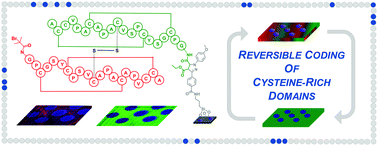Spatially resolved photochemical coding of reversibly anchored cysteine-rich domains†
Abstract
We present a novel methodology to generate recodable surfaces using cysteine-rich domains (CRD) via a combination of photolithography and reversible covalently peptide-driven disulfide formation. Therefore, two 21mer CRD peptide derivatives were synthesized, one bearing an electron deficient fumarate group for immobilization via nitrile imine-ene mediated cycloaddition (NITEC) to a tetrazole-functional surface. Secondly, a bromine moiety is introduced to the CRD for analytic labelling purposes to detect surface encoding. The photolithography is conducted by selectively passivating the surface with a polyethylene glycol (PEG)-fumarate via NITEC using a photomask in a dotted pattern. Consecutively, the CRD-fumarate is immobilized via NITEC adjacent to the PEG-functional areas to the unaffected tetrazole covered surface layer. Subsequently, the CRD-bromide is covalently linked to the CRD-fumarate by forming disulfide bonds under mild reoxidative conditions in a buffer solution. The CRD-bromide is released from the surface upon reduction to recover the prior state of the surface without the bromine marker. The analysis of the CRD precursors is based on electrospray ionization mass spectrometry (ESI-MS). The surface analytics were carried out via time-of-flight secondary ion mass spectrometry (ToF-SIMS), unambiguously verifying the successful immobilization as well as coding and decoding of the CRD-bromide on the surface based on dynamically reversible disulfide bond formation.



 Please wait while we load your content...
Please wait while we load your content...